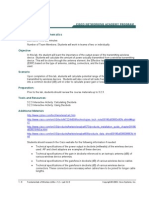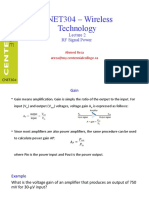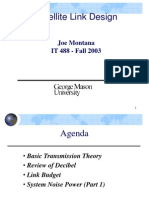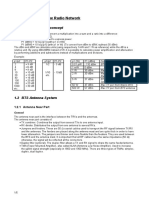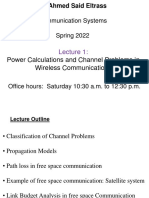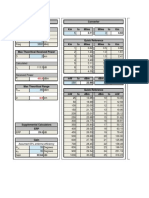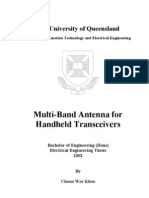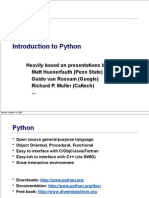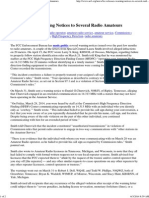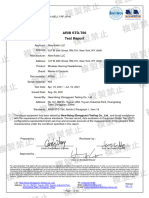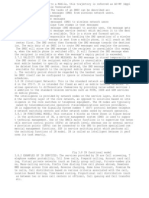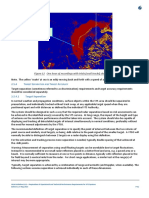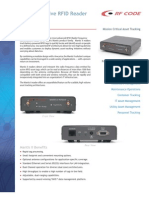RF Power Values
Document ID: 23231
Introduction
Prerequisites
Requirements
Components Used
Conventions
Power Level
Antennas
Effective Isotropic Radiated Power
Path Loss
Estimate Outdoor Ranges
Estimate Indoor Ranges
Networking Professionals ConnectionFeatured Conversations
Related Information
Introduction
This document defines radio frequency (RF) power levels and the most common measure, the decibel (dB).
This information can be very useful when you troubleshoot intermittent connectivity.
Prerequisites
Requirements
Cisco recommends that you have knowledge of basic mathematics, such as logarithms and how to use them.
Components Used
This document is not restricted to specific software and hardware versions.
Conventions
Refer to Cisco Technical Tips Conventions for more information on document conventions.
Power Level
The dB measures the power of a signal as a function of its ratio to another standardized value. The
abbreviation dB is often combined with other abbreviations in order to represent the values that are compared.
Here are two examples:
dBmThe dB value is compared to 1 mW.
dBwThe dB value is compared to 1 W.
You can calculate the power in dBs from this formula:
Power (in dB) = 10 * log10 (Signal/Reference)
�This list defines the terms in the formula:
log10 is logarithm base 10.
Signal is the power of the signal (for example, 50 mW).
Reference is the reference power (for example, 1 mW).
Here is an example. If you want to calculate the power in dB of 50 mW, apply the formula in order to get:
Power (in dB) = 10 * log10 (50/1) = 10 * log10 (50) = 10 * 1.7 = 17 dBm
Because decibels are ratios that compare two power levels, you can use simple math in order to manipulate
the ratios for the design and assembly of networks. For example, you can apply this basic rule in order to
calculate logarithms of large numbers:
log10 (A*B) = log10(A) + log10(B)
If you use the formula above, you can calculate the power of 50 mW in dBs in this way:
Power (in dB) = 10 * log10 (50) = 10 * log10 (5 * 10) = (10 * log10 (5)) +
(10 * log10(10)) = 7 + 10 = 17 dBm
These are commonly used general rules:
An Increase
of:
3 dB
A Decrease
of:
Produces:
Double transmit power
3 dB
Half transmit power
10 dB
10 times the transmit power
10 dB
Divides transmit power by 10
30 dB
1000 times the transmit power
Decreases transmit power
1000 times
30 dB
This table provides approximate dBm to mW values:
dBm
0
1
2
3
4
5
6
7
8
9
mW
1
1.25
1.56
2
2.5
3.12
4
5
6.25
8
�10
10
11
12.5
12
16
13
20
14
25
15
32
16
40
17
50
18
64
19
80
20
100
21
128
22
160
23
200
24
256
25
320
26
400
27
512
28
640
29
800
30
1000 or 1 W
Here is an example:
1. If 0 dB = 1 mW, then 14 dB = 25 mW.
2. If 0 dB = 1 mW, then 10 dB = 10 mW, and 20 dB = 100 mW.
3. Subtract 3 dB from 100 mW in order to drop the power by half (17 dB = 50 mW). Then, subtract 3 dB
again in order to drop the power by 50 percent again (14 dB = 25 mW).
You can find all values with a little addition or subtraction if you use the basic rules of algorithms.
Antennas
You can also use the dB abbreviation in order to describe the power level rating of antennas:
dBiFor use with isotropic antennas.
Isotropic antennas are theoretical antennas that transmit equal power density in all directions. They
are used only as theoretical (mathematical) references. They do not exist in the real world.
dBdWith reference to dipole antennas.
Isotropic antenna power is the ideal measurement to which antennas are compared. All FCC calculations use
this measurement (dBi). Dipole antennas are more realworld antennas. While some antennas are rated in
�dBd, the majority use dBi.
The power rating difference between dBd and dBi is approximately 2.2that is, 0 dBd = 2.2 dBi. Therefore,
an antenna that is rated at 3 dBd is rated by the FCC (and Cisco) as 5.2 dBi.
Effective Isotropic Radiated Power
The radiated (transmitted) power is rated in either dBm or W. Power that comes off an antenna is measured as
effective isotropic radiated power (EIRP). EIRP is the value that regulatory agencies, such as the FCC or
European Telecommunications Standards Institute (ETSI), use to determine and measure power limits in
applications such as 2.4GHz or 5GHz wireless equipment. In order to calculate EIRP, add the transmitter
power (in dBm) to the antenna gain (in dBi) and subtract any cable losses (in dB).
Part
A Cisco Aironet Bridge
That uses a 50 foot antenna
cable
And a solid dish antenna
Cisco Part Number
Power
AIRBR350AK9
20 dBm
AIRCAB050LLR
AIRANT3338
Has an EIRP of
3.35 dB
loss
21 dBi
gain
37.65
dBm
Path Loss
The distance that a signal can be transmitted depends on several factors. The primary hardware factors that are
involved are:
Transmitter power
Cable losses between the transmitter and its antenna
Antenna gain of the transmitter
Localization of the two antennas
This refers to how far apart the antennas are and if there are obstacles between them. Antennas that
can see each other without any obstacles between them are in line of sight.
Receiving antenna gain
Cable losses between the receiver and its antenna
Receiver sensitivity
Receiver sensitivity is defined as the minimum signal power level (in dBm or mW) that is necessary for the
receiver to accurately decode a given signal. Because dBm is compared to 0 mW, 0 dBm is a relative point,
much like 0 degrees is in temperature measurement. This table shows example values of receiver sensitivity:
dBm
10
3
0
3
10
mW
10
2
1
0.5
0.1
�20
30
40
50
60
70
0.01
0.001
0.0001
0.00001
0.000001
0.0000001
The receiver sensitivity of the radios in Aironet products is 84 dBm or 0.000000004 mW.
Estimate Outdoor Ranges
Cisco has an Outdoor Bridge Range Calculation Utility to help determine what to expect from an outdoor
wireless link. Because the outputs of the calculation utility are theoretical, it is helpful to have some
guidelines on how to help counteract outside factors.
For every increase of 6 dB, the coverage distance doubles.
For every decrease of 6 dB, the coverage distance is cut in half.
In order to make these adjustments, choose antennas with higher (or lower) gain. Or use longer (or shorter)
antenna cables.
Given that a pair of Aironet 350 Bridges (with 50 feet of cable that connects to a dish antenna) can span 18
miles, you can modify the theoretical performance of that installation:
If you change to 100foot cables instead of 50foot (which adds 3 dB of loss on each end), the range
drops to 9 miles.
If you change the antenna to 13.5dBi yagis instead of the dishes (which reduces gain by 14 dBi
overall), the range drops to less than 4 miles.
Estimate Indoor Ranges
There is no antenna calculation utility for indoor links. Indoor RF propagation is different than outdoor
propagation. However, there are some quick calculations that you can do in order to estimate performance.
For every increase of 9 dB, the coverage area doubles.
For every decrease of 9 dB, the coverage area is cut in half.
Consider the typical installation of an Aironet 340 Access Point (AP) with the rubber ducky 2.2dBi dipole
antenna. The radio is approximately 15 dBm. If you upgrade to a 350 AP and replace the rubber duckies with
a highgain omnidirectional antenna that is rated at 5.2 dBi, the range nearly doubles. The increase in power
from a 340 AP to a 350 AP is +5 dBi. And the antenna upgrade is +3 dBi, for a total of +8 dBi. This is close
to the +9 dBi that are required to double the distance.
Networking Professionals ConnectionFeatured
Conversations
Networking Professionals Connection is a forum for networking professionals to share questions, suggestions,
and information about networking solutions, products, and technologies. The featured links are some of the
most recent conversations available in this technology.
�NetPro Discussion Forums Featured Conversations for Wireless
Wireless Mobility: WLAN Radio Standards
Wireless Mobility: Security and Network Management
Wireless Mobility: Getting Started with Wireless
Wireless Mobility: General
Related Information
Cisco Aironet Antenna Reference Guide
Outdoor Bridge Range Calculation Utility
Intermittent Connectivity Issues in Wireless Bridges
Troubleshooting Connectivity in a Wireless LAN Network
Wireless LAN Technology Support
Technical Support & Documentation Cisco Systems
Contacts & Feedback | Help | Site Map
2007 2008 Cisco Systems, Inc. All rights reserved. Terms & Conditions | Privacy Statement | Cookie Policy | Trademarks of
Cisco Systems, Inc.
Updated: May 10, 2006
Document ID: 23231

